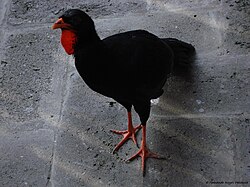| Highland guan | |
|---|---|
 | |
| male | |
| Scientific classification | |
| Kingdom: | Animalia |
| Phylum: | Chordata |
| Class: | Aves |
| Order: | Galliformes |
| Family: | Cracidae |
| Genus: | Penelopina Reichenbach, 1861 |
| Species: | P. nigra |
| Binomial name | |
| Penelopina nigra (Fraser, 1852) | |
 | |
The highland guan (Penelopina nigra) is a species of bird in the family Cracidae. It is found in the highlands of El Salvador, Guatemala, Honduras, southern Mexico, and Nicaragua. [2]
Contents
Its natural habitat is subtropical or tropical moist montane forest. Its population has declined much in recent times: Listed as a species of Least Concern in 1994, it was uplisted to Near Threatened in 2000 and, as it was determined to be less common than previously believed, to Vulnerable in the 2007 IUCN Red List. [3]





